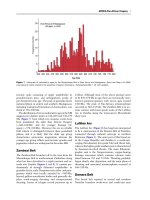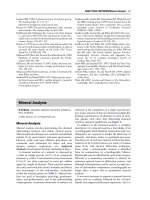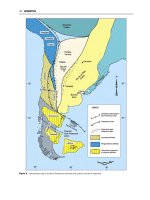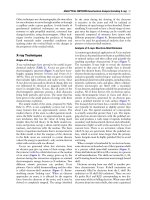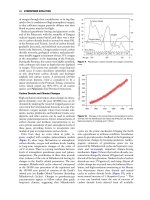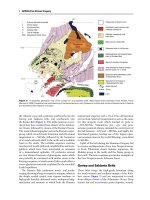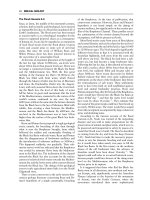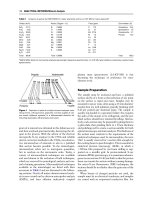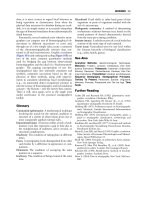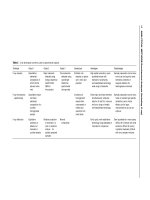Encyclopedia of geology, five volume set, volume 1 5 (encyclopedia of geology series) ( PDFDrive ) 2203
Bạn đang xem bản rút gọn của tài liệu. Xem và tải ngay bản đầy đủ của tài liệu tại đây (60.8 KB, 1 trang )
360 PRECAMBRIAN/Eukaryote Fossils
constrained, but possibly 620–780 Ma) of north-western Canada can be compared to chrysophyte skeletons.
Vase-shaped microfossils (Figure 3F) from the Chuar
Group and other Early Neoproterozoic successions
(e.g. the Visingsoă Formation in Sweden and the Draken
Conglomerate Formation in Spitsbergen) have been
interpreted as testate amoebae whose mineralized
tests are typically preserved in casts and moulds.
The Chuar testate amoeba fossils add another dimension to our consideration of the Neoproterozoic
biosphere, and that is heterotrophy. Because testate
amoebae are heterotrophic protists, the Chuar vaseshaped microfossils suggest that the Early Neoproterozoic biosphere was ecologically complex. Of course,
heterotrophic eukaryotes must have evolved earlier. In
fact, the earliest eukaryotes may be heterotrophic,
given that eukaryotic autotrophy evolved through primary and secondary endosymbiotic events. However,
evidence for heterotrophy in the fossil record is scarce.
Vase-shaped microfossils and ciliate biomarkers from
the Chuar Group are probably the earliest known
evidence for heterotrophic eukaryotes.
The best-known heterotrophic eukaryotes are perhaps the animals. There have been many reports of
animal fossils from Early Neoproterozoic and Mesoproterozoic successions, but their interpretation has
been controversial. Sinosabellidites huainanensis,
Pararenicola huaiyuanensis, and Protoarenicola baiguashanensis (Figure 3G), from the Huainan Group
and Huaibei Group (ca. 740–900 Ma) of northern
China, are some of the often-cited Early Neoproterozoic animal fossils. They are carbonaceous compressions of tubes of millimetric diameter and centimetric
length with transverse annulations. The transverse
annulations superficially resemble animal metameric
segmentation. A few specimens bear poorly defined
terminal structures that have been interpreted as proboscis-like structures. However, recent study has
shown that these carbonaceous compressions are
probably benthic tubular algae.
Middle Neoproterozoic
The Middle Neoproterozoic is characterized by multiple global glaciations, and is unofficially labelled as
the Cryogenian Period by some Precambrian geologists. On a broad scale, acritarchs and other eukaryotes suffered significant losses of diversity in the
Middle Neoproterozoic. The documented diversities
of several Middle Neoproterozoic assemblages are
extremely low, and such assemblages are typically dominated by Sphaerocongregus variabilis (or
Bavlinella faveolata). This Cryogenian drop in eukaryote diversity may be a true evolutionary pattern
that was related to the glaciation events. Despite the
loss of diversity, the occurrence of red algae, green
algae, photosynthetic stramenopiles, and testate
amoebae in Mesoproterozoic and Early Neoproterozoic rocks suggests that some members of these
groups must have survived the Middle Neoproterozoic glaciations.
Late Neoproterozoic
Eukaryote diversity rose sharply in the Late Neoproterozoic. Both acritarchs and multicellular algae
reached unprecedented levels of complexity and diversity in the Late Neoproterozoic. Some of the multicellular algae are preserved in anatomical detail,
allowing them to be placed within the red algae.
One of the most important landmarks in Late Neoproterozoic eukaryote evolution is the emergence of
animals and animal biomineralization. Molecularclock studies suggest that the deepest (protostomes–
deuterostomes) divergence within the crown-group
bilaterian animals probably occurred in the Mesoproterozoic or Early Neoproterozoic. But, as discussed
above, there is no convincing palaeontological evidence to support these molecular-clock estimates.
Some have suggested that perhaps the earliest animals
were microscopic in size and would not be well
preserved in the fossil record.
The Doushantuo Formation and Dengying Formation of South China provide several taphonomic
windows onto the Late Neoproterozoic biosphere.
Carbonaceous shales, cherts, and phosphorites of the
Doushantuo Formation (ca. 600–550 Ma) preserve
some of the most extraordinary eukaryote fossils in
the Neoproterozoic. More than 20 taxa of macroscopic carbonaceous compressions have been
reported from the Yangtze Gorges area and elsewhere
in South China. Most of these compressions can be
unambiguously interpreted as multicellular algae
(Figure 4A). Some of them show clear evidence of
holdfast anchoring, dichotomous branching, apical
meristematic growth, and specialized reproductive
structures. A few of these compressions (for example
Calyptrina striata and Sinospongia typica; Figure 4B),
however, have been interpreted as sponges or cnidarians, but such interpretations are not unique and an
algal interpretation cannot be falsified conclusively. In
any case, it is safe to conclude that none of the Doushantuo compressions can be interpreted as macroscopic bilaterians (bilaterally symmetrical animals).
Multicellular algae also occur in the Doushantuo
cherts and phosphorites. Cellular features are preserved (Figures 4C–F), so anatomical detail can be
deduced from these fossils. Many of these silicified
or phosphatized algal fossils show pseudoparenchymatous thallus construction, apical meristematic
